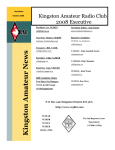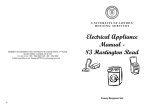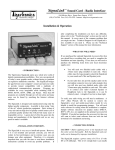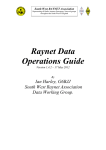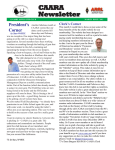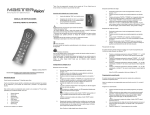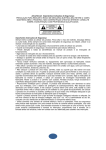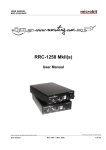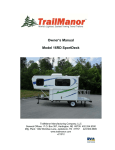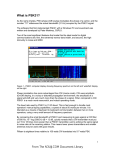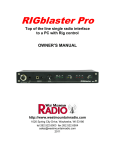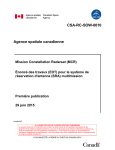Download October 2010 - Kingston Amateur Radio Club
Transcript
Newsletter Kingston Amateur Radio Club October 2010 2010 Executive President: Steve Cutway, VE3KC pres at ve3kbr.com Newsletter Editor: VA3PCI Assaf Shool news at ve3kbr.com Vice-Pres: Chip Chapman, VA3KGB vicepres at ve3kbr.com Treasurer: Doug Richards, VE3FFR treas at ve3kbr.com Repeater Committee: VE3KFS, Les Lindstrom (Chair) rptr at ve3kbr.com Secretary: David Sellick, VE3DZE sec at ve3kbr.com VA3GST, John Snasdell-Taylor va3gst at kos.net Past-Pres: Les Lindstrom, VE3KFS pastpres at ve3kbr.com VA3KGB, Chip Chapman va3kgb at rac.ca 2010 COMMITTEE CHAIRS: Two Metre Net Manager: VE3KC Steve Cutway netmanager at ve3kbr.com VE3JCQ, John Wood john686 at sympatico.ca VE3MNE, Don Gilroy dgilroy at cogeco.ca P. O. Box 1402 Kingston Ontario K7L 5C6 http://www.ve3kbr.com VE3KAR Clarendon Stn 147.090 (+) MHz VE3KBR Kingston 146.940(-) MHz 151.4Hz Tone VE3KER Kingston packet node 145.010 MHz simplex VE3UEL Hartington APRS node 144.390 MHz FROM THE PRESIDENT First, I’d like to welcome Assaf VA3PCI as our new newsletter editor. I hope you’ll give him the same strong support that you gave Joan. Remember, this is your newsletter. You all do something related to amateur radio. Share it. Tell the rest of us about it. Thanks to the 23 people who made the effort to attend the September meeting and who participated in the discussion about RAC with Stephen Mayne VE3LWX, RAC'S Assistant Director, Ontario North and East Region. Our guest speaker at the October meeting will be Phil VE3HST who will talk about Satellite Tracking and NEOSSAT. As Phil explains: It will be about the satellite tracking research we do at RMC with our telescope system, and the research we plan to do with our new NEOSSAT when it is launched in June. NEOSSAT is a joint DND-CSA satellite to track satellites and to detect earth-approaching asteroids. I'll bring our full-scale model of NEOSSAT. My presentation will consist completely of a series of jpg images. Congratulations to Rob VE3RPF who was recently appointed as an Assistant Director for the Ontario North and East Region, RAC. We now have a local voice at the table. Let’s get behind Rob and all join RAC to make it a stronger organization. Stephen reminded us that RAC is our national organization and we certainly need it with the ever-increasing demands for our frequencies, as was evidenced two weeks ago by a situation in Quebec - the temporary assignment of primary amateur frequencies for a non-amateur event - that should never have been allowed to happen. While on the subject of RAC, they will be holding what they’re calling a visioning meeting in Ottawa Oct. 29-31. John Bartlett’s document, “Transforming RAC” has been updated and posted on the KARC Freelist. If you aren’t subscribed and would like a copy, send me an e-mail <[email protected]>. I encourage you to read this document and make comments to RAC through the blog available at: http://blog.rac.ca Even if you don’t have any comments, read the blog and see what others are saying. KARC will be participating in the 2010 Boy Scouts Jamboree on the Air (JOTA) Oct. 15-16 at Frontenac Provincial Park. Mike VE3TD, is a leader in the scouting organization and will be co-ordinating our effort. He is looking for volunteers. Terry VA3KLG, Doug VE3FFR and Chip VA3KGB have volunteered so far. Youth is the future of amateur radio and this is an excellent opportunity to attract them. The KARC fleamarket is set for Saturday, Nov. 13th from 08:30 to 11:30 at the Military Communications and electronics Museum. Admission is a financial donation to the museum and tables are $10 each and can be reserved by contacting Terry VA3TRM <[email protected]>. Thanks, Terry, for organizing this again. There will be a Club table that anyone can put 'fleas' on with proceeds going to the Club. Like last year, the fleamarket will be preceded by a breakfast buffet at the Garrison Golf and Country club from 07:30 to 09:00. $5.50 per person. I will run the talk-in on VE3KBR. ONTARS is also interested in having controllers from the museum early in the net to help promote the fleamarket. Anyone interested, please contact me. So check your basements and shacks and bring all the equipment you’re no longer using. If you need help, just ask your better halves. :-) I look forward to seeing everyone at the October 6th meeting and to hearing Phil VE3HST’s presentation. Until then, 73s and good DX. Steve VE3KC MEMBER ARTICLE Review of the Tigertronics SignaLink USB By Assaf Shool VA3PCI Overview In the pioneering days of PCs, hams quickly realized the power of connecting their rigs to a PC via sound card, and using inexpensive or free software to explore the world of digital communications. Except that this often consisted of random connecters from liberated gadgets and homemade PC boards of not always the best construction. The end result was often prone to picking up stray noise and breaking down as flimsy cables and questionable build quality gave out. Most of us (myself included) have at least one of these contraptions laying around! One solution is Tigertronic’s SignaLink USB. It’s not inexpensive at about ~$120 retail, but I have found the reduced hassle, cable count and high reliability is well worth it. Let’s take a look. The Hookup Only 2 cables are really necessary for hookup (see Figure 3). A standard USB cable to the PC, and another cable from the SignaLink to your rig’s accessory, data, or mic port. The USB cable comes included but since the latter cable varies in type depending on what kind of rig is being used it does not. However, for a few dollars more ($14-$35 depending on the rig), you can order one prebuilt for a plug-and-play solution. You also have the option of building one yourself. Tigertronics does include an unterminated cable to get you started. For the rig end, you will likely need some type of DIN connector, the number of pins varying depending on which the type of radio being used. You will also need to dig through various manuals and pinout diagrams to figure out which pins need to be soldered to what wires. I decided to spring for the premade cable. One nice feature of USB is that an external power source is not required. That’s one less wall wart to add to the clutter and for me that is a big plus. The only challenging portion of connecting this unit is setting the jumpers. Inside, (see Figure 1) a 16-pin socket is present. Small jumper cables are included in the box, and you would bridge these across the socket so the correct pin, such as audio out, on the SignaLink, is connected to the correct pin on the rig’s Data/Accessory or even microphone port. Thankfully, the included CD has extensive diagrams for many makes and models,. As well, they offer plug-in modules that are hardwired for particular rigs. Tigertronics even throws in the Allen key you will need to open the unit. Figure 1: Yellow jumper wires (included) configure the unit to operate with the IC-7000 in this case. Notable features are high-quality SMD construction and audio isolation transformers. The 3 extra jumpers (JP2, JP3, and JP4) are there to help expand the unit’s compatibility to work with virtually any radio. I use an Icom IC-7000 and it only took a few moments to connect the 4 jumper wires needed according to the provided diagram. Once this was complete, I plugged the cable between the rig and the SignaLink, and the standard AB-style USB cable to my PC. Although drivers are included on the CD, any modern operating system recognizes it as a USB sound card and installs the built in drivers. Extensive and well written setup instructions are available in the manual. Note, however, the SignaLink USB does not offer CIV control of your radio, but this isn’t essential to getting the most from the unit. The front of the unit is simple and easy to understand. Starting from the left, a red “Power” button is provided. This is somewhat of a lie as the unit is powered at all times when connected to your PC via USB, the “Power” button simply restricts transmit operation as well as operation of the remainder of the controls. “TX” and “RX” dials provide simple volume adjustment. Although the unit acts as a USB sound card and receives at all times, even when powered “off”, the RX adjustment knob is only effective when the PWR button is depressed. The “DLY” knob takes a bit more explaining. This unit keys the radio when audio output is present on its internal sound card. The moment you begin transmitting with a program such as MMSSTV, an internal relay will engage, the radio is keyed and audio will be fed in. The DLY adjustment sets how long your rig will stay keyed after audio has stopped. For some data modes, such as packet, you want this to be zero as to not miss a reply. For others, you may want it higher to prevent keying and unkeying the rig unnecessarily fast. Figure 3: Hookup couldn't be any simpler, or could it?? The back of the unit provides us with 5 more connections. The two easy ones are the USB and RJ-45 connectors which I have already discussed. The other 3 I find somewhat confusing and could have been labeled better. The first 3.5mm jack is labeled “SPKR”. It would seem logical to me that a jack labeled SPEAKER is meant to be connected to a speaker, however such an assumption would be wrong. This is actually an input jack, intended to take speaker-level output from your rig and feed it into the SignaLink. It’s actually a handy feature if you are connecting the SignaLink to your radio via its Mic jack which seldom feature receive audio output, but for the rest of us it might seem confusing. “Audio Input”, or even just “IN”, may be a clearer way to define what the purpose of this jack is. The second jack is “AUX”, or auxiliary, which I found confusing because I have no idea if it is auxiliary input to the unit or an auxiliary output. It could even be seen as perhaps a port for an auxiliary keyer. However, it is indeed an output jack that lets you monitor receive audio from the rig. Why they couldn’t have just labeled it RX AUDIO or just plain RX is anyone’s guess. The last available jack is “MON”. Ambiguity sets in again as it is unclear if it is meant to monitor received or transmitted audio. A look at the manual shows it is for transmitted audio. Again they could have labeled this “TX MON”. Although these terms are explained in the user manual, if you ever find yourself fiddling with this unit in the middle of the night or in the field it’s quite inconvenient to have to start flipping through the manual after you have plugged your speakers into the Speaker jack and no audio can be heard. Labeling problems aside, setup is easy, and the manual is well-written in a detailed but easy to understand way. It covers just about every conceivable problem and provides solutions. I would recommend reading it to get the most out of the unit and to avoid setup problems. A few words of caution The SignaLink will key up your radio and begin transmitting whenever your PC sends sound to its internal sound card. It doesn’t know the difference between the Windows startup sound, PACTOR, and sounds from web pages. I recommend that after it’s plugged in that you make sure that Windows (or whatever OS you are using) does not designate it as the default sound card. In addition, on some radios such as my IC-7000, keying the radio in any way, even from the accessory jack, will make the Mic hot and will transmit ambient sounds in addition to what you may want to transmit from your PC. While potentially comical, this may also lead to undesired consequences. Using the unit I can’t speak for other OS’s, but for Windows XP to Windows 7, no software setup or drivers are required. Just plug the unit into an available USB port and Windows will automatically install the built-in generic USB audio drivers. Obtaining ham radio software can be a trying affair, often entailing spending hours scouring homemade web pages with dancing hula hoop girls and “under-construction” images, assuming the link to what you actually want hasn’t become a 404 Error since 2004 when the page was last updated. Thankfully, TigerTronics has already done all this for you and the included CD comes with such handy programs as MMSSTV, DigiPan, AGW Packet software, MixW, WinPSK and other essentials. If you want more, the Tigertronics website has an extensive link collection to other popular programs. I decided to fire up MMSSTV and test the unit. For configuration, I pointed MMSSTV to the device ID of the unit, then adjusted the RX level on the SignaLink to bring audio to an acceptable level. I tuned my Icom IC-7000 to 14.230Mhz USB and images started appearing immediately. Transmitting is also very easy. After you have prepared your rig to transmit, simply instruct MMSSTV to send out the image you want. The SignaLink detects that there is audio present and automatically keys the radio and begins transmitting. At this point, you would adjust the TX LEVEL knob on the SignaLink and watch your rig’s ALC indicator to calibrate the audio to an appropriate level. The only hiccup I encountered was with the free AGW Packet Driver. For some reason, I cannot get it to understand that it needs to use the SignaLink for both transmitting and receiving. It insists on using it for one function, and using my PC’s sound card for another. I worked around this by running a patch cable from the SignaLink’s RX Audio port to the PC sound card’s line in port. I don’t have enough room here to cover the extensive library of software available to use. Virtually everything I’ve tested it with, from Digital Master 780 included with Ham Radio Deluxe, to ACARS decoding to HF Weather Fax software has yielded very good results. Overall I would give this unit 4.5 / 5. Specifications Power Supply: Audio Freq Response: Sampling Size/Rate: Computer OS: USB Port Powered 100Hz - 10Khz (Limited by LPF) 16 Bits, All standard rates are supported up to 48Khz Other Connectors: Case: Dimensions: Windows 98SE, ME, 2000, XP, Vista & Windows 7 MAC OS 9.1 or later MAC OS X 10.00 or later Linux This depends on the program that you are running 600 Ohm (nom). TX/RX Levels are fully adjustable for compatibility with Hi-Z and Low-Z radio connections. Adjustable Transmit "Hang Time", 30 ms to 3 seconds Relay (1 Amp Max) TX Audio, RX Audio, PTT, GND - RJ-45 RX Audio/Speaker - 3.5mm Mono USB 1.1/2.0 Compatible Standard USB "B" type connector Aux. Speaker - 3.5mm Mono Extruded Aluminum - 6061T4 1.6" x 3.2" x 3.6" Operating Temp: -30C to +60C Computer Hardware: Radio In/Out Z: Auto-PTT™ Delay: PTT Circuit: Radio Connector: Computer Connector: For more information, visit http://www.tigertronics.com AGENDA KINGSTON AMATEUR RADIO CLUB, INC October 6, 2010 At Smitty's Restaurant, back room 7:00 p.m. 1. Members introduce themselves 2. Additions to the agenda 3. Minutes of the September 2010 meeting - errors/omissions/approval (David VE3DZE) 4. Treasurer's report (Doug VE3FFR) 5. Business arising from the Minutes 6. New business (a) Possible creation of a QCWA chapter to serve Prince Edward and Frontenac Counties (b) Appointment of Rob VE3RPF as a RAC Assistant Director, Ontario North and East (c) Other items 7. Reports: (a) President (Steve VE3KC) (b) Repeaters (Les VE3KFS) (c) RAC (Rob VE3RPF) (d) Net Manager (Steve VE3KC) (e) Web page (Chip VA3KGB) (f) KARC Newsletter (Assaf VA3PCI) (g) JOTA - Oct. 16, 2010 (Mike VE3TD) (h)Fleamarket - Nov. 13, 2010 (Terry VA3TRM) (i) 'Hearts and Flowers' (j) Other reports 8. Date of next meeting - Nov. 3, 2010. Assaf VA3PCI will talk about his radio scanner software. 9. Adjournment 10. Break and 50/50 draw Guest Speaker: Phil VE3HST MEETING MINUTES KINGSTON AMATEUR RADIO CLUB, INC HELD ON Wednesday 1 Sept 2010 At Smitty’s Restaurant Princess Street, Kingston Ontario The Kingston Amateur Radio Club meeting was called to order by our president Steve VE3KC at 7:00 PM. VE3KTG Kristopher Allen Korzan (a new Kingston HAM) and visitor VE6CCL Robert Wilson were welcomed. 1. The members present introduced themselves. There were 21 members in attendance. 2. There were no additions to the agenda. 3. Minutes: our president asked for approval of the June meeting minutes as published in the newsletter. The motion was moved by Michael VE3PRW and seconded by George VE3GHK and was passed. 4. Treasurer’s Report: The report was read by Doug VE3FFR. We had a closing balance of $6246.40 after expenses. Doug VE3FFR Moved, seconded by Michael VE3PRW that the Treasurer’s Report be adopted as read. Motion carried. 5. Old Business Chip has added the KARC Photo gallery to the web site and members can access and add photos. No other old business. 6. New Business: a) Fleamarket - Nov. 13, 2010: Flea market will be held Nov 13th 2010 at the base Museum hosted by Terry VA3TRM. Setup at 7:00 AM. Breakfast at the Garrison Golf Club at 7:30. Doors open at 8:30. For those wishing tables, contact Terry at his new email address [email protected] b) Newsletter: Joan has retired from the newsletter and Assaf VA3PCI has volunteered to take on the position of editor. There will be a presentation to Joan in October. c) Proposed amendments to Club Bylaws: Steve VE3KC presented some amendments to the bylaws (published in the newsletter). Article 1. For administrative and legal purposes, the Head Office of the Club shall be located at the Residential street address of the President. Article 14. Term of Office. Executive members shall be elected annually at the December general meeting and shall hold Office for one calendar year commencing on the first day of January of the year following the election. Regulation 2. MEMBERSHIP FEES The annual fees for Full and Associate membership in the Club shall be recommended by the Executive and approved at a general meeting. This fee shall be payable on admission to Membership annually for the fiscal year January 1 to December 31. Any dues paid on or after September 1 shall be for the next fiscal period, but shall not preclude the member from participating in the club business for the period of September 1 to December 31 of the preceding year. Motion was made by Michael VE3PRW and seconded by Mike VE3TD the motion was passed. The membership fee remains the same $20. There was a motion made by Phil VE3HST and seconded by Herman VA3QX to allow a $10 fee for immediate family members living at the same address and the motion passed. d) JOTA and JOTI: The floor was handed over to Mike VE3TD to explain about JOTA (Boy Scout Jamboree on the air and on the Internet, to be held at the Frontenac Provincial Park October 16th, setup on Friday the 15th.All HAMS welcome. Call sign to be used will be VE3SFD. e) Other items: Phil VE3HST has been holding a “Geometry net” on KBR Sundays at 11:00 AM that has been going over well. 7. Reports: A) President: See the report in the newsletter. b) RAC Report: No report. c) Repeaters: Les VE3KFS said that both machines are running fine. Les and Don VE3MNE will be headed north to add tones (151.4) to the KAR machine (it will identify the same way as the KBR machine does.) The Simplex IRLP machine continues to operate smoothly. The Quad repeater is still not up and running. #73 will shut off the echo test if the problem crops up again. d) Net Manager: Steve VE3KC thanked the controllers who kept the net alive this summer. He said that checkins ranged from 8 to 18, and nets ran 17 to 56 minutes. He thanked those who contributed trivia questions, which he said was a popular segment of the net. e) KARC Newsletter: Steve VE3KC referred everyone to the September newsletter that is now on the web site. f) WebPage: Chip VA3KGB reported that the website is working well. He is working on the photo gallery instructions. He said that we have had a million and a half hits on the site for the year. g) FCARES: David VE3DZE said that they had two lighthouse activations and one island activation (132 contacts). The FCARES newsletter has just come out www.fcares.net h) Hearts and Flowers: the XYL of Bill VE3NFU is not well. Warren VE3JPW is also unwell. i) Other Reports: RAC has contacted Rob VE3RPF further to his interest in helping them. 8. Date of the next meeting is October 6th, 2010. Phil VE3HST will talk about the Neosat satellite tracking system software he’s working on at RMC. 9. 50/50 draw $18.00 worth of tickets was sold. Terry VA3KLG won $9.00 and donated it back. 10. Adjournment: Roy VE3VJF, seconded by John VE3GST, moved to adjourn. Motion carried. During the break, Rob VE3RPF took photos of those that brought Rockmites to the meeting for an article he’s working on for our newsletter and TCA. The meeting was followed by a presentation by Stephen Mayne VE3LWX, RAC'S Assistant Director, Ontario North and East, who spoke about RAC’s future and answered the many questions presented to him by KARC members. David Sellick VE3DZE Secretary Kingston Amateur Radio Club Inc. FINANCIAL STATEMENT Kingston Amateur Radio Club Financial Statement Sept 2010 Income Membership 190.00 50/50 Draw 20.00 IRLP 30.00 Total Income 240.00 Overall Total 240.00 Bank Balance As of Sept 30, 2010 6486.40 NET CONTROL SCHEDULE October 5 October 12 October 19 October 26 November 2 November 9 November 16 November 23 November 30 December 7 December 14 December 21 December 28 VE3CAK John VE3DZE David VE3JPW Warren VE3KC Steve VE3NFU Bill VA3PCI Asaf VE3SIQ George VE3TD Mike VE3VJF Roy VE3CAK John VE3DZE David VE3JPW Warren VE3KC Steve NET CONTROL SCRIPT Revised Apr. 19, 2010 [Before you start the net, please turn off the repeater identifier by issuing the key sequence '300' on your touchtone keypad. If you don't have a touchtone keypad, ask someone else to issue the key sequence for you.] Good evening. This is [callsign], net control station for the Kingston Amateur Radio Club’s Tuesday night Net. My name is ----. The Kingston Amateur Radio Club Tuesday Night Net is an informal net that meets at 1930 hours every Tuesday evening on the Kingston repeater, VE3KBR, 146.940 MHz, with a 151.4 Hz tone required on the input, 146.340 MHz. We welcome participation by all amateurs. Before continuing, is there any emergency or priority traffic? Please call now. The purpose of the net is to take check-ins; to inform you of KARC activities; to provide news from other radio clubs and news of interest to Radio Amateurs. Information about KARC may be found on the web site (www.ve3kbr.com) or by contacting any of our club executive members. I will take check-ins giving priority to mobiles, portables and stations checking in via EchoLink or IRLP. When checking in, please give your call sign phonetically, your name and location, and indicate whether you have any traffic or announcements for the Net. Are there any stations using EchoLink or IRLP wishing to check in? Please call now. Are there any mobiles wishing to check in? Please call now. Are there any portables wishing to check in? Please call now. Are there any base stations wishing to check in? Please call now. Trivia Time Here’s tonight’s trivia question(s). Swap Shop Are there any items for the swap shop? Closing Are there any additional check-ins or announcements before I end the Net? That concludes this evening's Kingston Amateur Radio Club Tuesday Night Net. Thank you for participating. We had [number] check-ins this evening. 73. This is [callsign] returning the repeater to normal amateur use. [Please remember to turn on the identifier again after the net by issuing the key sequence '301' on your touchtone keypad. If you don't have a touchtone keypad, ask someone else to issue the key sequence for you.]















